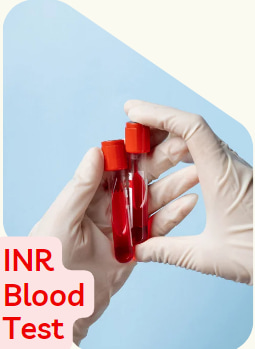Content :
◉ what is INR blood test?
The International Normalized Ratio (INR) blood test is a laboratory test that measures the blood's ability to clot. It is a standardized way of reporting prothrombin time (PT), which is a measure of how long it takes for blood to clot.

◉ Why it's done?
The purpose of INR test is to measure and monitor the clotting ability of blood, primarily in patients who are taking oral anticoagulant medications such as warfarin (Coumadin).
INR is used to standardize and compare prothrombin time (PT) results among different laboratories and test systems to ensure accurate and consistent monitoring of the medication's effect on blood clotting.
The INR value helps healthcare providers adjust the dosage of anticoagulant medication to maintain the desired level of blood thinning, reducing the risk of excessive bleeding or blood clots.
The goal of monitoring the INR is to maintain a target range specific to each individual's condition, to ensure that the blood does not clot too easily or too slowly. If the INR values are too high, it indicates that the blood is taking longer to clot, increasing the risk of bleeding. Conversely, if the INR values are too low, it suggests that the blood may be clotting too quickly, increasing the risk of blood clots.
◉ Preparations before INR test
Before an INR test, it is important to follow these preparations:
- Inform your healthcare provider about any medications or supplements you are taking, as certain medications can affect the results. This includes both prescription and over-the-counter drugs.
- Let your healthcare provider know if you have any bleeding disorders or conditions that may affect blood clotting.
- Follow any instructions given by your healthcare provider regarding fasting before the test. In some cases, you may be asked to avoid eating or drinking anything except water for a certain period of time before the test.
- Follow your healthcare provider's instructions regarding the timing of your medication dose. For example, you may be advised to take your anticoagulant medication at a specific time before the test.
- Wear a short-sleeved or loose-fitting shirt on the day of the test to make it easier for the phlebotomist or healthcare provider to access your arm.
It is always best to consult with your healthcare provider for specific instructions before the INR test.
◉ Normal levels of INR
The normal range for INR blood test can vary slightly depending on the specific medical condition being treated and the type of anticoagulant medication being used.
In general, a normal INR range is between 0.8 and 1.2 for individuals not on anticoagulant therapy.
For patients on warfarin or other anticoagulant medications, a target INR range is typically established based on the specific medical condition being treated.
For most conditions, an INR target of 2.0 to 3.0 is commonly used. However, for certain conditions such as mechanical heart valve replacement or recurrent blood clotting disorders, a higher INR target may be necessary, typically between 2.5 and 3.5.
◉ High levels of INR
High levels of INR indicate that the blood is taking longer than usual to clot. This can be a result of being on anticoagulant medication, such as warfarin (Coumadin), which is used to thin the blood and prevent clotting.
In some cases, high INR levels may also be caused by liver disease, vitamin K deficiency, or certain medical conditions that affect blood clotting.
◉ Low levels of INR
Low levels of INR indicate that the blood is clotting too quickly. This can be caused by several factors, including:
- Inadequate response to anticoagulant medication: Some individuals may have a reduced response to anticoagulant medication, leading to less effective blood thinning and lower INR levels.
- Vitamin K supplementation: Vitamin K is needed for the production of clotting factors in the blood. If a patient is taking vitamin K supplements, it can counteract the effects of anticoagulant medication and lead to lower INR levels.
- Genetic factors: In rare cases, genetic factors can affect the metabolism and response to anticoagulant medication, resulting in lower INR levels.
◉ Related analytical tests
Other tests that may be done in conjunction with an INR test include:
- Prothrombin time (PT): This test measures the time it takes for blood to clot and is often used in conjunction with the INR test to monitor the effectiveness of anticoagulant therapy.
- Activated partial thromboplastin time (APTT): APTT measures the time it takes for blood to clot and is used to evaluate the effectiveness of anticoagulant therapy, especially for patients on heparin.
- Thrombin time: This test measures the time it takes for a fibrin clot to form and can help evaluate certain bleeding disorders or monitor specific anticoagulant therapies.
- D-dimer test: This test measures the presence of a protein fragment called D-dimer, which is released when a blood clot breaks down. It is used to help diagnose or rule out blood clots, such as deep vein thrombosis or pulmonary embolism.
- Factor assays: These tests measure the levels of specific clotting factors in the blood, such as factor VIII or factor IX, to evaluate bleeding disorders or monitor specific clotting factor replacement therapies.
◉ Conclusion
INR analysis plays an essential role in the management of anticoagulant treatments, helping to maintain an optimal balance between clot prevention and bleeding risk.
The precise interpretation may vary depending on the patient's medical context. Consultation with a healthcare professional is always recommended for accurate interpretation of results.